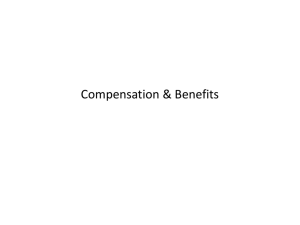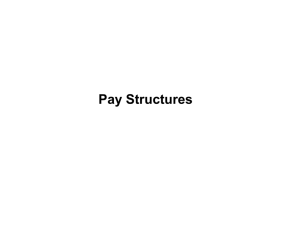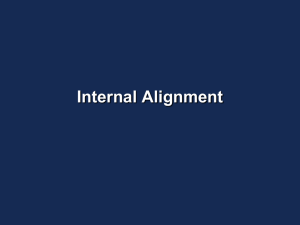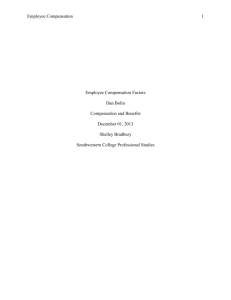Compensation & Benefits
advertisement
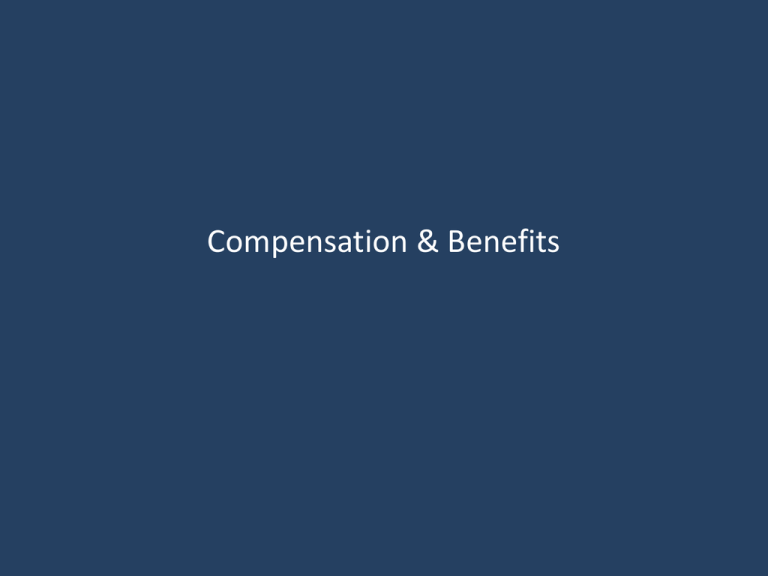
Compensation & Benefits Questions • What is included in compensation? • When should someone receive compensation? • How does compensation help to improve organizational performance and give a sustained competitive advantage? What is Compensation? Compensation refers to all forms of financial returns and tangible services and benefits an employees receive as part of an employment relationship (Milkovich, Newman, & Gerhart, 2011) A “Total Returns” Perspective (Milkovich, Newman, & Gerhart, 2011) Phases in a “Total Rewards” Program (Heneman, 2007) Milkovich et al., Version of the Same Ideas (Milkovich, Newman, & Gerhart, 2011, p. 43) Who Are the Stakeholders? • • • • • • • Management Employees Shareholders (if publicly traded) Taxpayers (if publicly funded) Customers Government Society in General Exhibit 1.1: Hourly Compensation Costs for Manufacturing Workers (in U.S. Dollars) (Milkovich & Newman, 2008) See p. 5 for updated #s What is a “Strategic Perspective”? A strategic perspective focuses on those competitive choices that help the organization gain and sustain competitive advantage. (Milkovich, Newman, & Gerhart, 2011) Corporate objectives strategic plans, vision, and values What business should we be in? How should total compensation help us win? Business unit strategies HR strategies How do we win (gain competitive advantage) in those businesses? How should HR help us win? Social, competitive, and regulatory environment Strategic compensation decisions Compensation systems Employee attitudes and behaviors Strategic Choices Competitive advantage (Milkovich & Newman, 2008) See p. 37 of current text Generic Business Strategies • Innovator • Cost Cutter • Customer-focused (Milkovich, Newman, & Gerhart, 2011) Tailor the Compensation System to the Strategy Business Response Strategy Innovator: Increase Product Complexity and Shorten Product Life Cycle • Product Leadership • Shift to Mass Customization and Innovation • Cost Cutter: Focus on Efficiency HR Program Alignment • Committed to Agile, Risk Taking, Innovative People • Reward Innovation in Products and Processes • Market-Based Pay • Flexible – Generic Job Descriptions Cycle Time • Focus on • Operational Excellence • Pursue Costeffective Solutions (Milkovich, Newman, & Gerhart, 2011, p. 38) Compensation System • Do More With Less Competitors’ Labor Costs • Increase Variable Pay • Emphasize Productivity • Customer Focused: Increase Customer Expectations • Customer Intimacy • Deliver Solutions to Customers • Speed to Market • Delight Customer, Exceed Expectations Focus on System Control and Work Specifications • Customer Satisfaction Incentives • Value of Job and Skills Based on Customer Contact So strategy provides the overall context and framework to guide HR decisions, including compensation. There are many alternatives to achieve the given objectives, even when using the same strategic approach, therefore… We value processes and activities to create a rational, coherent, or “fair” system that can be communicated effectively, attracts and retains key talent, and increases or maintains participants’ motivation and performance. Four Policy Choices That Provide Framework for Text • Internal alignment - Consistency of comparisons among jobs/skill levels inside an organization (a.k.a. “internal equity”) • External competitiveness - Consistency of comparisons of similar jobs between organizations (i.e., “the market”; a.k.a. “external equity”) • Individual alignment - Comparisons regarding performance and compensation between individuals (a.k.a. “individual equity”) • Compensation Administration or Management - Policies to ensure “the right people get the right pay for achieving the right objectives in the right way” (Milkovich, Newman, & Gerhart, 2011)
